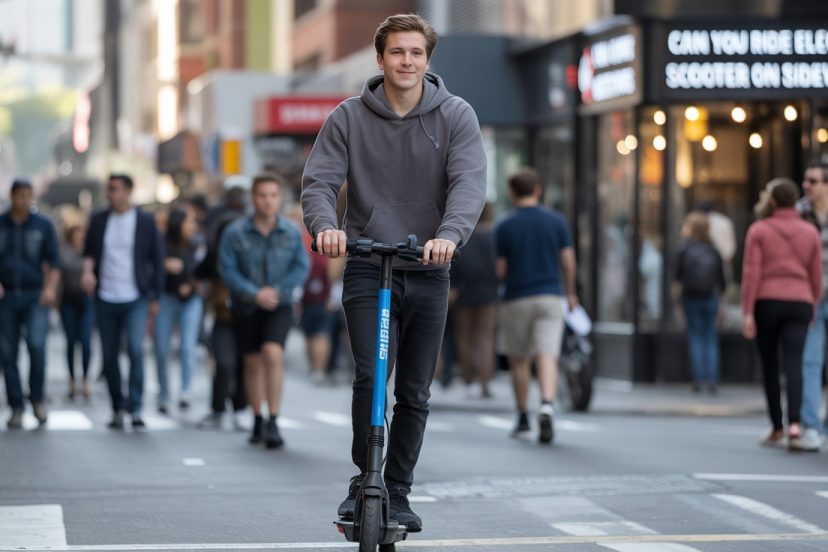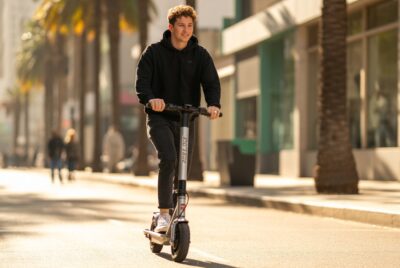Can You Ride Electric Scooter on Sidewalks?
*We may earn a commission for purchases made using our links. Please see our disclosure to learn more.
The gentle hum of an electric scooter gliding down a quiet street has become the soundtrack of modern urban transportation. Yet for many riders, the question can you ride electric scooter on sidewalks remains frustratingly unclear. Picture this: a commuter steps onto their electric scooter for the morning journey to work, only to face a maze of conflicting information about sidewalk regulations, street rules, and local ordinances that seem to change from block to block.
Understanding the issue of can you ride electric scooter on sidewalks is not just about avoiding fines. It is about ensuring the safety of pedestrians, protecting riders from legal complications, and fostering a harmonious relationship between different modes of urban transportation. The confusion exists because the rapid rise of electric scooters has moved faster than the creation of clear, unified laws in many areas.
“The integration of electric scooters into urban transportation systems requires careful balance between innovation and safety, with clear regulations that protect all road users while promoting sustainable mobility options.”
– Urban Transportation Safety Institute
Key Takeaways
- Most jurisdictions prohibit electric scooter riding on sidewalks to protect pedestrian safety
- Bike lanes and designated paths are typically the preferred riding areas for electric scooters
- Local regulations vary significantly between cities, states, and countries
- Penalties for sidewalk riding can include fines ranging from $25 to $500
- Age restrictions and licensing requirements differ by location
- Safety equipment requirements vary but often include helmets for younger riders
The Complex Landscape of Electric Scooter Regulations
Understanding the Legal Framework
The regulatory environment surrounding electric scooters represents a patchwork of federal guidelines, state laws, and local ordinances. Unlike traditional vehicles with decades of established legal precedent, electric scooters occupy a unique category that legislators are still working to define clearly.
At the federal level, the Consumer Product Safety Commission provides basic safety standards for electric scooters, but transportation regulations are primarily handled at state and local levels. This decentralized approach has created a situation where riders must navigate different rules depending on their exact location, sometimes changing requirements from one city block to the next.
State-Level Variations in Sidewalk Policies
States with Clear Sidewalk Prohibitions
Many states have enacted legislation specifically prohibiting electric scooter operation on sidewalks. California, for example, explicitly forbids motorized scooter use on sidewalks under Vehicle Code Section 21235. Similar prohibitions exist in New York, Florida, and Texas, though enforcement and specific penalties vary.
For anyone wondering can you ride electric scooter on sidewalks, the answer in these states is clearly no. These prohibitions typically stem from safety concerns regarding pedestrian-vehicle interactions. Sidewalks are designed as pedestrian spaces, and the introduction of motorized vehicles—even relatively low-speed ones—can create dangerous situations, particularly for elderly pedestrians, children, and individuals with mobility challenges.
States with Conditional Allowances
Some jurisdictions permit sidewalk riding under specific circumstances. These conditional allowances might include:
- Speed restrictions limiting scooters to walking pace (typically 3-4 mph) when on sidewalks
- Dismount zones requiring riders to walk their scooters in high-traffic pedestrian areas
- Time-based restrictions allowing sidewalk use during off-peak hours
- Age-based permissions permitting younger riders to use sidewalks while requiring adults to use streets
Local Municipal Approaches
Progressive Integration Models
Forward-thinking cities have developed comprehensive frameworks for electric scooter integration. These municipalities often designate specific lanes or paths for micro-mobility devices, creating infrastructure that separates scooters from both vehicular traffic and pedestrian areas.
Some cities have implemented “slow zones” where electric scooters are permitted on sidewalks but with mandatory speed governors that limit maximum velocity to pedestrian walking speeds. These technological solutions represent innovative approaches to balancing accessibility with safety.
Restrictive Urban Policies
Other cities have taken more restrictive approaches, particularly in dense urban cores where sidewalk space is limited and pedestrian traffic is heavy. These areas often enforce strict no-sidewalk policies with significant financial penalties for violations.
Business districts, tourist areas, and entertainment zones frequently have enhanced restrictions due to high pedestrian volumes and safety concerns. Riders in these areas must typically use bike lanes or designated scooter parking areas.
Safety Considerations and Risk Assessment
Pedestrian Safety Dynamics
The primary concern driving sidewalk restrictions centers on pedestrian safety. Electric scooters, even at moderate speeds, can cause significant injury in collisions with pedestrians. The silent operation of electric motors means pedestrians may not hear approaching scooters, increasing the risk of unexpected encounters.
When asking can you ride electric scooter on sidewalks, safety must be a key part of the discussion. Statistical analysis of micro-mobility accidents shows that pedestrian-scooter incidents, while less frequent than car-pedestrian accidents, often result in serious injuries due to the unexpected nature of the interaction and the vulnerability of both parties involved.
Infrastructure Limitations
Many sidewalks lack the width necessary to safely accommodate both pedestrians and scooters. Standard sidewalk widths, designed for foot traffic, become congested when additional vehicles are introduced. This congestion creates safety hazards and accessibility issues, particularly for individuals using mobility aids or families with strollers.
The surface quality of sidewalks also presents challenges for electric scooter operation. Uneven pavement, pedestrian obstacles, and architectural features like benches or planters can create hazardous conditions for scooter riders, potentially leading to accidents that affect both riders and nearby pedestrians.
Enforcement Mechanisms and Penalties
Citation and Fine Structures
Law enforcement agencies employ various strategies for regulating electric scooter use. Some jurisdictions treat sidewalk violations as minor infractions similar to parking tickets, while others classify them as moving violations with more serious consequences.
Common penalty structures include:
- First offense warnings in some municipalities
- Fixed fines ranging from $25 to $200 for sidewalk violations
- Escalating penalties for repeat offenders
- Scooter impoundment in cases of repeated violations
- Point systems affecting driver’s licenses in some states
Technology-Assisted Enforcement
Modern enforcement increasingly relies on technology to monitor compliance. GPS tracking in rental scooters allows companies to identify sidewalk usage and implement automatic penalties or speed restrictions. Some cities require scooter-sharing companies to provide usage data to help with enforcement efforts.
Geofencing technology enables automatic speed reduction or disable features when scooters enter prohibited areas, representing a proactive approach to regulation compliance that reduces the burden on traditional law enforcement.
Practical Guidance for Riders
Pre-Ride Planning
Successful electric scooter use requires careful route planning that considers local regulations, infrastructure availability, and safety factors. Riders should research their intended routes to identify legal riding areas, potential hazards, and alternative paths if primary routes become unavailable.
Mobile applications and mapping services increasingly include micro-mobility routing options that account for local regulations and suggest optimal paths for electric scooter travel. These tools help riders navigate complex regulatory environments while maintaining legal compliance.
Situational Awareness Strategies
Effective electric scooter operation requires heightened situational awareness, particularly when transitioning between different regulatory zones. Riders must remain alert to changing signage, infrastructure cues, and local traffic patterns that might indicate regulatory changes.
Understanding the difference between bike lanes, multi-use paths, and restricted areas becomes crucial for maintaining compliance. Visual indicators, pavement markings, and signage systems vary between jurisdictions, requiring riders to develop adaptability in interpreting local guidance.
Emergency Situations and Exceptions
Most jurisdictions recognize that emergency situations may require temporary sidewalk use for safety reasons. When considering can you ride electric scooter on sidewalks during emergencies, it is important to know that these exceptions are typically limited to immediate safety threats and require riders to return to legal riding areas as soon as safely possible.
Mechanical failures, severe weather, or dangerous traffic conditions might justify temporary sidewalk use, but riders should be prepared to explain their circumstances if questioned by law enforcement and should prioritize returning to legal riding areas quickly.
The Evolution of Electric Scooter Infrastructure
Emerging Infrastructure Solutions
Cities worldwide are developing innovative infrastructure solutions to accommodate electric scooters while maintaining pedestrian safety. Protected bike lanes, dedicated micro-mobility corridors, and shared-use paths represent evolving approaches to urban transportation integration.
Some municipalities have implemented “scooter streets” with reduced speed limits and enhanced safety features specifically designed for mixed micro-mobility use. These pilot programs provide valuable data on effective integration strategies and inform future infrastructure development.
Future Regulatory Trends
The regulatory landscape continues evolving as governments gain experience with electric scooter integration. Emerging trends include standardized safety requirements, improved rider education programs, and technology-assisted compliance monitoring.
Regional coordination efforts aim to reduce regulatory fragmentation and create more consistent rules across jurisdictional boundaries. These initiatives recognize that modern transportation patterns often cross municipal boundaries and require coordinated regulatory approaches.
Technology Integration Opportunities
Advanced technologies offer promising solutions for regulatory compliance and safety enhancement. Smart helmets with heads-up displays can provide real-time regulatory information, while vehicle-to-infrastructure communication systems can automatically adjust scooter behavior based on local requirements.
Artificial intelligence and machine learning applications can help predict optimal routing, identify potential safety hazards, and provide personalized guidance for individual riders based on their experience levels and local conditions.
Building Community Acceptance
Stakeholder Engagement Strategies
Successful electric scooter integration requires active engagement with diverse community stakeholders, including pedestrian advocacy groups, business owners, and accessibility organizations. These conversations help identify concerns, develop solutions, and build consensus around appropriate regulatory approaches.
Community education programs that explain electric scooter regulations, safety practices, and proper usage etiquette contribute to broader acceptance and compliance. These initiatives often involve partnerships between government agencies, scooter companies, and community organizations.
Addressing Accessibility Concerns
Electric scooter regulations must consider the needs of individuals with disabilities and mobility challenges. Sidewalk policies should account for accessibility requirements while maintaining safety standards that protect all community members.
Universal design principles in infrastructure development ensure that micro-mobility integration enhances rather than reduces accessibility for individuals with diverse mobility needs. This includes maintaining clear pedestrian pathways and ensuring that scooter parking doesn’t obstruct accessibility features.
Economic Implications and Urban Planning
Transportation Cost Analysis
Electric scooters represent a significant economic factor in urban transportation systems. Regulatory decisions about sidewalk use affect operational costs for scooter-sharing companies, infrastructure investment requirements, and enforcement expenses for municipalities.
Cost-benefit analyses of different regulatory approaches help inform decision-making by quantifying safety improvements, infrastructure costs, and economic impacts on various stakeholders. These analyses support evidence-based policy development that balances multiple community priorities.
Integration with Public Transit
Electric scooters increasingly serve as first-mile and last-mile solutions that complement public transportation systems. Regulatory frameworks that support this integration can enhance overall transportation efficiency while reducing environmental impacts and traffic congestion.
Coordinated planning between transit agencies and micro-mobility regulators creates opportunities for seamless multi-modal transportation experiences that benefit riders and support broader urban sustainability goals.
Conclusion
The question can you ride electric scooter on sidewalks reflects broader challenges in adapting urban infrastructure and regulations to emerging transportation technologies. While most jurisdictions prohibit sidewalk riding to protect pedestrian safety, the specific rules vary significantly based on location, circumstances, and local priorities.
Successful navigation of electric scooter regulations requires ongoing attention to local laws, commitment to safety practices, and engagement with community discussions about appropriate integration strategies. As cities continue developing comprehensive approaches to micro-mobility, riders must remain informed, adaptable, and committed to sharing urban spaces responsibly.
The future of electric scooter regulation will likely involve continued evolution toward more standardized, technology-assisted approaches that balance innovation with safety. By staying informed about current regulations—especially when asking can you ride electric scooter on sidewalks—and participating in local dialogue, riders can help shape policies that support safe, efficient, and inclusive transportation.
The journey toward effective electric scooter integration represents an ongoing process of learning, adaptation, and compromise. Success requires collaboration between riders, regulators, and communities to create transportation systems that serve diverse needs while maintaining safety and accessibility for all urban residents.
Frequently Asked Questions
Q: Can I ride my electric scooter on the sidewalk if there’s no bike lane available?
A: In most jurisdictions, the absence of bike lanes doesn’t create an exception for sidewalk riding. You’re typically required to use the street or find alternative routes with legal riding areas. Some cities provide maps of designated scooter routes to help riders find appropriate paths.
Q: What happens if I get caught riding my electric scooter on the sidewalk?
A: Penalties vary by location but commonly include fines ranging from $25 to $500. Some areas issue warnings for first offenses, while others may impound scooters for repeat violations. The specific consequences depend on local regulations and enforcement policies.
Q: Are there any exceptions that allow sidewalk riding in emergency situations?
A: Most jurisdictions recognize emergency exceptions for immediate safety threats, but these are typically limited situations. Mechanical failures, dangerous traffic conditions, or severe weather might justify temporary sidewalk use, but riders should return to legal areas as soon as safely possible.
Q: Do electric scooter sidewalk rules apply to privately owned scooters or just rentals?
A: Sidewalk regulations typically apply to all electric scooters regardless of ownership. Private owners are subject to the same rules as rental scooter users, though enforcement methods may differ. Some cities have additional registration requirements for privately owned scooters.
Q: How can I find out the specific electric scooter laws in my area?
A: Check with your local city government website, state transportation department, or local law enforcement for current regulations. Many cities now provide specific micro-mobility information pages with maps of legal riding areas. Municipal parking authorities and transportation departments are often good resources for current information.




